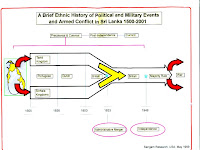A Brief Colonial History Of Ceylon(SriLanka)
Sri Lanka: One Island Two Nations
A Brief Colonial History Of Ceylon(SriLanka)
Sri Lanka: One Island Two Nations
(Full Story)
Search This Blog
Back to 500BC.
==========================
Thiranjala Weerasinghe sj.- One Island Two Nations
?????????????????????????????????????????????????Saturday, February 1, 2020
Positive ties with India, a key foreign policy focus for SL
Pictures, it is said, speak louder than words and the picture
accompanying this column is sound proof of this. It shows India's
outgoing High Commissioner to Sri Lanka Taranjit Singh Sandhu warmly
welcoming President Gotabaya Rajapaksa to a farewell reception that was
held in H.C. Sandhu's honour at India House, Colombo, on January 27. The
Indian H.C. is expected to take up duties as India's ambassador to the
US shortly.
Among other things, the picture is, to a degree, reflective of India's
readiness to not only engage in bridge-building with its closest
neighbours but to also steadily bolster these links. The Indian H.C.'s
body language itself is positive and one would not be wrong in
concluding that it's in some way indicative of the positive orientation
that India has been in the process of introducing into its regional
policy. It will be in India's neighbours' interests to respond to their
economic super power neighbour in the same positive and proactive
fashion if there's to be a degree of cordiality and stability in the
inter-state ties of South Asia.
Needless to say, India's neighbours' relations with her have continually
attracted controversy over the decades on numerous questions, but it
needs to be considered that the India of today is not the India of
yesteryear. As should be obvious, India has grown into a foremost power
in a number of vital respects over the past 30 years and these
substantive changes call for corresponding policy changes with regard to
India on the part of her neighbours.
How these inter-state relations could be solidified was lucidly and
concisely outlined by H.C. Sandhu at the farewell function and if the
smaller states of South Asia are in need of a clearer understanding on
how they could strengthen their ties with India, it was all there in
this impromptu address by the outgoing H.C. Dwelling awhile on
Indo-Lanka economic relations, the H.C. said that in her journey towards
economic prosperity, it was the intention of India to take Sri Lanka
along with her. There could be no question of India growing and
prospering alone. Rather, it would be shared economic well being between
her and Sri Lanka.
However, there are things that Sri Lanka ought to do if she is to
benefit from this economic growth spurt, it was pointed out. Sri Lanka,
on her part, must increasingly link-up with India on the economic plane
and make best use of the growth opportunities that are opening up as a
result of India integrating steadily with the global economy. The
Indo-Lanka Free Trade Agreement ought to facilitate this process, one is
inclined to think. And with India increasingly linking with the world
economy, these opportunities for Sri Lanka ought to multiply.
Accordingly, the onus is on Sri Lanka to do the needful on this score.
She must establish constructive economic bridges with India or integrate
her economy progressively with that of India.
What goes for Sri Lanka goes for the rest of India's neighbours. Being,
of course, physically the biggest and economically the most dynamic and
growing of South Asian countries, it would be self-defeating for India's
neighbours to ignore her presence. The most commonsensical thing for
these neighbours to do is to link-up with her and make optimal use of
the growth opportunities that are opening-up.
It should be considered that India is in the process of becoming a major
gateway to the hugely-growing ASEAN region. Underlying India's 'Look
East' policy, for example, or her initiative to develop her hitherto
relatively economically backward North East region, is the consideration
that once developed this region could increasingly open-up to the ASEAN
region where the economic opportunities are growing phenomenally.
Consequently, those of India's neighbours that link-up with India's
North East could in turn enjoy the opportunity of integrating with
ASEAN's dynamic economies.
Besides, there are growing economic linkages between India's North-East
and China's South-West region. This is as a result of both major
economic powers stressing the importance of making their peripheral
regions grow with the aim of integrating them closely. These
constructive ties between the countries are usually glossed over or
ignored by the international and South Asian mainstream media but these
initiatives constitute a marked departure from what is considered
dominant thinking on regional economic development. The expectation of
both countries is that the development of these peripheral regions would
lead to 'synergies of growth' between them and countries of the ASEAN
region, some of which are at the doorstep of India's North-East.
If the visits undertaken of late by some of Sri Lanka's political
leaders to India are anything to go by, the crucial and growing
importance of India to Sri Lanka and the region is seemingly dawning on
Sri Lanka. However, it is not clear whether the challenges awaiting this
country in their entirety in the Indo-Lanka ties context are being
addressed by this country's political leadership.
What is absolutely clear, though, is that the local political leadership
should outgrow Sri Lanka's old set ways of thinking on Indo-Lanka
relations. It is amply clear that India is extending to us a hand of
friendship. We must grasp it in our interest.

